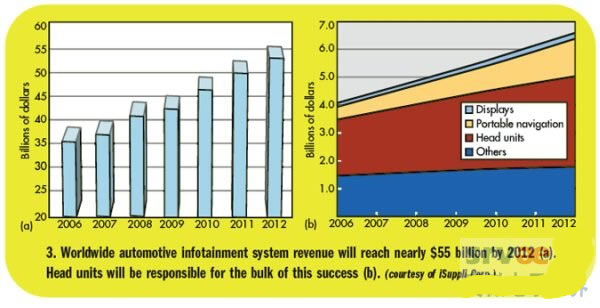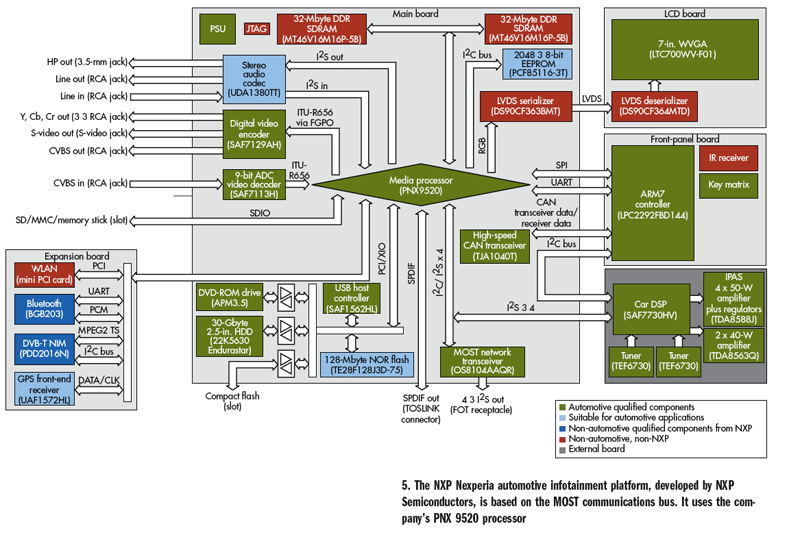Now, drivers and passengers want to enjoy the comfort of technology as they do at home. Consumer demand for traditional in-vehicle infotainment systems, such as CD players, is giving way to products that support content downloadable. Today, cars are best compatible with mobile phones, MP3 players, GPS devices and other portable media platforms.
This article refers to the address: http://
Portable and wireless connection
The latest automotive hard disk drive (HDD) capacity is currently 40GB or larger and is fully used to store multimedia information. For example, Toshiba's 0.85-inch MK2001MT has 120GB, which is suitable for storing music and movies.
However, all of this data requires a powerful and flexible database management system (DBMS). Integrators and mobile device developers use Toshiba's small Entier to effectively add advanced search capabilities to their products. It was designed with the limitations of small devices in mind, with complex text search, incremental search, conceptual search, and spatial search, as well as alias handling.
Last year, for the 2007 car, Chrysler introduced a new option called the MyGIG hard-drive navigation system, similar to the systems already introduced by Mitsubishi and Lexus (see Figure 1). Unlike hard drives and CDs, the hard drive navigation system has faster navigation recalculation and better graphics and interfaces. MyGIG is an HDD that can store and play audio files on your hard drive, just like installing a permanent iPod in your car.
TomTom and Johnson Controls jointly developed a mobile Bluetooth device gateway last year with the goal of being deployed in the 2008 model (see Figure 2). This component enables electronic products such as the TomTom satellite navigation system to communicate with the vehicle's network for innovative and secure navigation. The user uses Johnson Control's speech recognition technology to verbally command the TomTom GO device for easier use. Consumers will be able to experience a variety of intuitive functions, such as automatically telling the shortage of fuel and the direction of the nearest gas station.
STMicroelectronics announced this year that it has launched a broadcast chip for the Sirius Satellite Radio Backseat TV Service. The system transmits live television of the home television network to the video screen of the selected vehicle.
main market
These developments, combined with a variety of network protocol choices, drive automakers, Tier 1 suppliers and chipmakers to rethink the way they offer automotive infotainment products and services to consumers.
So what are the main challenges facing designers? They must find good ways to develop consumer electronics that are very short-lived and compatible with cars with long life cycles. Undoubtedly, the company can be profitable in a lucrative market.
According to market analysis firm iSuppli, worldwide car production will reach 82 million in 2012, and the total market for automotive entertainment chips will grow from $36 billion in 2006 to $54 billion in 2012 (see Figure 3). Shipments of portable navigation devices will double from 14 million this year to 42 million in 2012 (see Figure 4).


This prediction is based on a variety of global interconnection and communication protocols for information entertainment and embedded control, including wired connectivity and the rapidly growing demand for wireless connectivity using Bluetooth and USB protocols.
Two major organizations, AutoSar (Automatic Open Source Architecture) and Jaspar (Japan Automotive Software Platform Architecture), are promoting the development of network protocols. The goals of both groups are the same: reducing software development costs, improving software reliability, and making automotive electronics more affordable. In fact, AutoSar's architecture targets most of the existing network protocols (see "A Plethora Of Automotive Networking Protocols" at , Drill Deeper 16157).
Platform and cooperation
Meeting a variety of network protocols is a huge challenge for automotive chip manufacturers. As the consumer demand for infotainment functions changes rapidly, it is most difficult to predict which protocol requires which silicon chip functionality. In addition, the life of the car is much longer than the life of the chip it uses.
One solution is to build a platform chip that supports many of these protocols, even if it does not support all such protocols. Another approach is to collaborate with other chip manufacturers, Tier 1 suppliers, and automakers early in the design cycle.
For example, SMSC strongly supports the adoption of Media Oriented Systems Technology (MOST) standards in the North American automotive infotainment market, and its INIC eLITE technology platform provides a simple automotive network solution that enables low-cost multimedia links.
Texas Instruments (TI), using its OMAP (Open Media Application Platform) architecture, recently demonstrated what it calls the industry's first application processor capable of playing back 720p high-definition (HD) video for high-end mobile phones. TI hopes to apply this technology to automotive applications as well.
TI also said that the OMAP3430 is the first application processor to integrate the newly defined OpenGL ES 2.0 graphics standard. In addition, two new members of the scalable OMAP 3 processor family will help handset manufacturers design smart phones with robust multimedia capabilities at the lowest cost. This voice-activated connection enables hands-free wireless communication, either via Bluetooth or a dashboard, anywhere in the car.
Freescale Semiconductor manufactures devices that support FlexRay, AutoSar, Jaspar, mobileGT NEXUS 5001, LIN, and SPARC protocols. Its i.MX31 multimedia application processor is the engine of the integrated Ford/Microsoft Synchronous Protocol car infotainment system.
The 400MHz device runs the Microsoft operating system and processes audio signals for hands-free operation. At the same time, handle all the voice recognition functions of Sync. The Sync system provides voice control for mobile phones and MP3 players like iPod and Zune.
NEC Electronics works closely with automotive Tier 1 suppliers and automakers to estimate market demand. John Bridwell, technical director of automotive strategy business at NEC Electronics USA, said: "It is a daunting challenge for IC manufacturers to predict what new features and functions are needed."
Jens Eltze, chief technical engineer at NEC Automotive Strategic Business Unit, said: "We use our experience in audio signal processing in the consumer market to meet the changing consumer demand for automotive electronics."
Freescale recently partnered with Tilcon Software to launch a telematics application platform that is a hybrid hardware/software solution that enhances graphics display performance. Freescale's Media5200 processor platform works in conjunction with the Tilcon Interface Development Kit (IDS).
NXP Semiconductors announced a reference design for a MOST system based on the company's Nexperia platform, using the NXP 9520 processor (see Figure 5), which will be used in the 2008 Chrysler vehicle, with the goal of utilizing Real-time GPS data and 3D rendering engine for car-mounted camera video.

Pierre Mehn, Marketing Manager for Software and Video Processing Products, Automotive Entertainment Solutions Business Unit, NXP Semiconductors, said, "The future automotive infotainment capabilities require intelligent design to meet both the proliferation of standards and long product cycles. Our Nexperia platform represents one A new design paradigm for dealing with these issues."
The company recently announced that it has won a major customer, Sirius Satellite Radio, which uses NXP's 9250 processor to drive Sirius' 2008 Chrysler rear-seat TV. Two out of every three cars in the world have at least one NXP card radio chipset.
operating system
The increasing complexity of automotive infotainment systems poses a continuing challenge for operating system (OS) software providers to launch suitable platforms, regardless of which chip or bus protocol is used (see "The OS Is King In Automotive Infotainment" Drill Deeper 16158).
According to Andrew Pollack of QNX Software, "The reliability and analytical capabilities of many operating systems are not suitable for today's and tomorrow's infotainment systems. Software will be the key to classifying car infotainment systems."
Pearl Cotton Bag Cutting Machine
Pearl Cotton Bag Cutting Machine,Front Sealing Bag Cutting Machine,High-Speed Bag Cutting Machine,Square Bottom Bag Cutting Machine
Dongguan Yuantong Technology Co., Ltd. , https://www.ytbagmachine.com